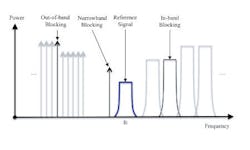LTE Device Testing: from Theory to Measurement
The high data rates, carrier aggregation, and multiple-input multiple-output (MIMO) operation of LTE devices creates a complex transmitter (Tx) and receiver (Rx) measurement environment. In an application note titled, “Introduction to LTE Device Testing: From Theory to Transmitter and Receiver Measurements,” National Instruments helps to decipher LTE device testing from the signal structure to measuring spurious emissions. Three categories are covered in this document: LTE and LTE Advanced (LTE-A) structure/theory of operation, LTE Tx measurements, and LTE Rx measurements.
The note describes LTE and its use of the orthogonal frequency division multiplexing (OFDM) scheme. For the uplink, LTE is modulated with OFDM-access (OFDMA). It uses multiple subcarriers grouped into resource blocks in order to accommodate multiple users. Using single-carrier frequency division multiple access (SC-FDMA) and Fast Fourier Transform (FFT) techniques, that uplink approach can apply pre-coding before the symbols are modulated onto subcarriers. This method reduces the peak-to-average power ratio (PAPR) of the transmission. Up to eight input antenna and eight output antenna are possible in release 10 of the LTE-A standards. In addition, up to five carriers can be aggregated to create a higher data rate without using higher-order modulation schemes.
Going on to describe the Tx measurements, the note details power, signal-quality, and spectrum measurements for LTE transmitters. The bulk of LTE Tx testing is done according to the 3GPP TS 36.521 section of the LTE standard. It requires a combination of a vector signal generator (VSG) and vector signal analyzer (VSA). Both the lowest and highest bandwidth configurations are required for testing LTE devices under various modulation schemes for maximum output-power tolerance.
In the LTE standard, 3GPP TS 36.521 section 7 describes the necessary Rx measurements from a reference sensitivity level to adjacent-channel selectivity and spurious emissions. The note specifies that these measurements only apply to the handset receiver and not to typical receiver components, such as low-noise and power amplifiers. The primary figure of merit for an LTE Rx is receiver throughput, which is a measure of the data rate through the Rx hardware. This is exemplified with LTE sensitivity being defined as the lowest average power level required for the Rx to achieve 95% of the throughput maximum.
National Instruments, 11500 N Mopac Expwy, Austin, TX 78759-3504(877) 388-1952
About the Author
Jean-Jacques DeLisle
Jean-Jacques graduated from the Rochester Institute of Technology, where he completed his Master of Science in Electrical Engineering. In his studies, Jean-Jacques focused on Control Systems Design, Mixed-Signal IC Design, and RF Design. His research focus was in smart-sensor platform design for RF connector applications for the telecommunications industry. During his research, Jean-Jacques developed a passion for the field of RF/microwaves and expanded his knowledge by doing R&D for the telecommunications industry.

